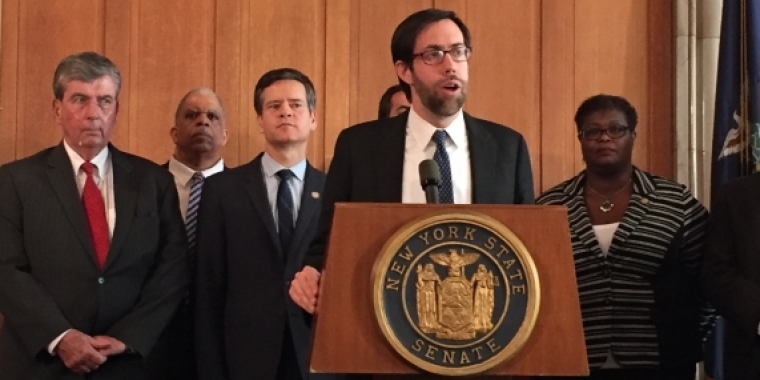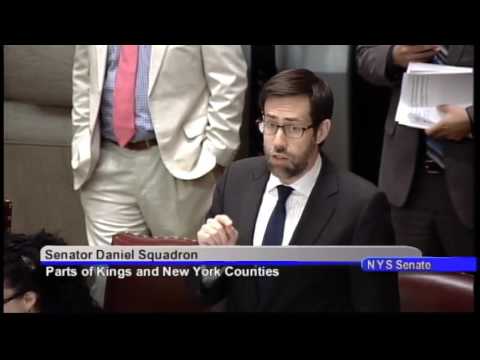
Senator Squadron Testimony Regarding Intercity Buses: New York City Council Committee on Transportation
October 7, 2011
October 6, 2011
My name is Daniel Squadron and I represent the 25th District in the New York State Senate. My district includes the Manhattan neighborhoods of Tribeca, Battery Park City, the Lower East Side, Chinatown, the Financial District, Little Italy, SoHo and the East Village and the Brooklyn neighborhoods of Greenpoint, Williamsburg, Vinegar Hill, DUMBO, Fulton Ferry, Brooklyn Heights, Cobble Hill, Carroll Gardens and Gowanus. Thank you for the opportunity to testify at this hearing.
This hearing comes at an important moment in the national dialogue about the management and regulation of intercity buses. A series of fatal bus crashes around the country, as well as the need to manage the hundreds of intercity and charter buses coming into our neighborhoods here at home, have exposed what many of us have known for years: the existing regulations are a tangled web with complex oversight by dozens of agencies in the federal, state, and city governments. I commend the chair for continuing the dialogue about an issue that is important to the health and quality of life in neighborhoods throughout the city, as well as the safety of thousands of people that travel to and from New York City.
This City Council committee is looking at two pieces of federal legislation that seek to increase the safety of intercity buses. The Motor Coach Enhanced Safety Act of 2011 (H.R. 873/S. 453) and the Bus Uniform Standards and Enhanced Safety Act of 2001 (H.R. 1390) both lay out steps to accomplish many of the same goals, but there are differences between the two bills that the Council should consider. Both bills would increase driver training and require disclosure of business relationships, thereby preventing bad operators from running multiple companies in order to avoid compliance. But where the Motor Coach Enhanced Safety Act requires safety modifications to motor coaches, including the addition of seat belts, stronger glazing, crush-resistant roofs, and fire safety mechanisms within two years, the Bus Uniform Standards and Enhanced Safety Act simply tasks the Secretary of Transportation with research on the best methods and standards and the prescription of new industry requirements after three years.
In an effort to protect bus operators — many of which are important small businesses — the Bus Uniform Standards and Enhanced Safety Act provides financial assistance and requires compliance in two phases, with 100% compliance in 12 years. While I appreciate that we must support small businesses that provide a service upon which millions rely, I join Senators Schumer and Gillibrand in their support of the Motor Coach Enhanced Safety Act of 2011 (H.R. 873/S. 453). We must institute strong industry reforms as quickly as possible.
The third piece of legislation you are considering, New York State bill A8133/S5171B, would strengthen the requirements for bus drivers, including a mandatory background check. I voted for this bill in the Senate, and I encourage the Assembly and Governor to support it.
However, none of these pieces of legislation alone will provide all the necessary industry reforms to protect New York City riders. Toward that end, I urge the Council to also support a bill that I introduced with Assembly Speaker Sheldon Silver, with the support of Council Member Margaret Chin (S2977-2011). The proposed legislation would authorize New York City to pass a local law to regulate intercity passenger buses through a permit system, which would include assigning pick-up/drop-off locations, providing for community board and MTA input, and regulating enforcement. Permits could be issued for up to three years, and holders would pay the city an annual fee. By providing the city with key information about bus companies, problems will be identified before they become tragic.
With this legislation, we have the opportunity now to implement coordinated, systemic changes that can both enhance quality of life and also ensure the safety of bus passengers.
I represent Manhattan’s Chinatown, one of the hubs for intercity buses in New York City. With no rules to regulate buses, the streets of Chinatown are like the wild west. The permit system would replace today's chaotic lack of rules, which has caused myriad problems for communities and bus companies — including congestion, pollution and inefficiency. The permit system is intended to improve the health, safety and welfare of the public and neighborhood residents —addressing challenges that have arisen with the rapid expansion of the affordable bus industry in the last 15 years — but will also be a big step toward increased safety.
The bus permit system would require buses that enter and leave New York City to provide information about their company, which will be easily accessible and organized in one central database. Companies that want to serve New York City, regardless of the location of their headquarters, will be unable to avoid providing crucial information, allowing the city to track whether they are meeting safety requirements. New York City will be able to cross-reference data with the Federal Motor Carrier Safety Administration (FMCSA) and the United States Department of Transportation (USDOT) to identify problematic operators before tragedy strikes.
On their own, the proposed federal and state reforms will not give the city and the state the tools to protect against venue shopping. If bus companies’ principal owners and drivers must register to operate in New York City, and that information is captured and cross-referenced with the federal database, the city and state will be better able to force operators to comply.
Currently, as we recently learned of World Wide Travel, the company responsible for the fatal crash in the Bronx, a fleet of buses could be registered by a company under one name in one state, but they may operate under another name in several surrounding states. The New York City permitting system will require the principals of bus companies to disclose their information, which will allow the city, state and federal governments to coordinate enforcement and prevent future accidents.
The Motor Coach Enhanced Safety Act of 2011 and New York State bill A8133/S5171B in the Council’s resolution go a long way to give agencies the tools they need to regulate the bus industry. However, only my bus-permitting legislation, S2977-2011, gives us the opportunity to ensure that those with hazardous safety records will be prevented from doing business on our streets. Any overhaul of bus regulations must happen at a federal, state, and city level, and I look forward to working with you and our colleagues in government toward positive solutions for our constituents and bus passengers, in New York and throughout the country.
Thank you for the opportunity to testify today.
Share this Article or Press Release
Newsroom
Go to NewsroomSquadron Honors Local Students For Community Engagement
June 27, 2016


What Happened (And Didn't) in Albany
June 18, 2016

